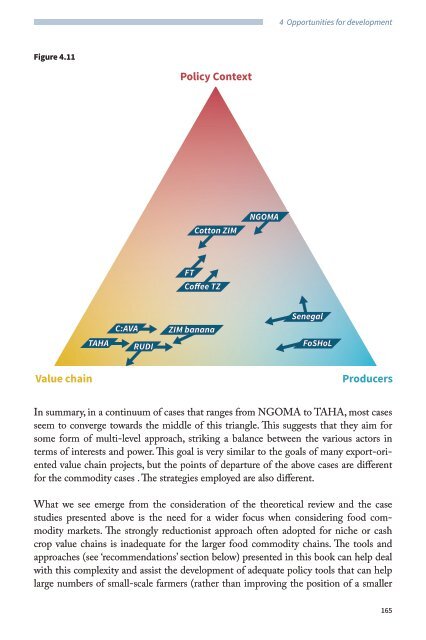- Page 1 and 2:
Editors: Fred Zaal, Jacqueline Slui
- Page 3 and 4:
Regional Markets for Local Developm
- Page 6 and 7:
Acknowledgements Acknowledgements F
- Page 8 and 9:
Foreword Bart de Steenhuijsen Piter
- Page 10 and 11:
Photo: ©FAO/Paballo Thekiso / FAO
- Page 12 and 13:
1 Introduction The challenge is to
- Page 14 and 15:
1 Introduction in this publication
- Page 16 and 17:
1 Introduction agro-related service
- Page 18 and 19:
1 Introduction is used). Market kno
- Page 20 and 21:
1 Introduction their borders to foo
- Page 22 and 23:
1 Introduction When individual valu
- Page 24 and 25:
2 Inclusion of smallholder farmers
- Page 26 and 27:
2 Inclusion of smallholder farmers
- Page 28 and 29:
2 Inclusion of smallholder farmers
- Page 30 and 31:
2 Inclusion of smallholder farmers
- Page 32 and 33:
2 Inclusion of smallholder farmers
- Page 34 and 35:
2 Inclusion of smallholder farmers
- Page 36:
2 Inclusion of smallholder farmers
- Page 39 and 40:
Regional Markets for Local Developm
- Page 41 and 42:
Regional Markets for Local Developm
- Page 43 and 44:
Regional Markets for Local Developm
- Page 45 and 46:
Regional Markets for Local Developm
- Page 47 and 48:
Regional Markets for Local Developm
- Page 50 and 51:
3 Cases Photo: ©FAO/Daniel Hayduk
- Page 52 and 53:
3 Cases RUDI empowers micro-small e
- Page 54 and 55:
3 Cases The last type is the larger
- Page 56 and 57:
3 Cases Transport The two main mode
- Page 58 and 59:
3 Cases Impact of the intervention
- Page 60 and 61:
3 Cases opportunities need to be co
- Page 62 and 63:
3 Cases Photo: Lora Forsythe 3.3 Ad
- Page 64 and 65:
3 Cases matter (e.g. dust) and—mo
- Page 66 and 67:
3 Cases the sun-dried HQCF VC. The
- Page 68 and 69:
3 Cases feedstock for processing in
- Page 70 and 71:
3 Cases (USD 39 to USD 46 per ton f
- Page 72 and 73:
3 Cases Photo: ©FAO/Simon Maina /
- Page 74 and 75:
3 Cases than 7,000 smallholders in
- Page 76 and 77:
3 Cases tices, productivity and qua
- Page 78 and 79:
3 Cases Infrastructure and governan
- Page 80:
3 Cases One unanticipated developme
- Page 83 and 84:
Regional Markets for Local Developm
- Page 85 and 86:
Regional Markets for Local Developm
- Page 87 and 88:
Regional Markets for Local Developm
- Page 89 and 90:
Regional Markets for Local Developm
- Page 92 and 93:
3 Cases Photo: ©FAO/Giampiero Dian
- Page 94 and 95:
3 Cases be secured at lower prices.
- Page 96 and 97:
3 Cases Figure 3.2 FoSHoL seed prod
- Page 98 and 99:
3 Cases secure some additional inco
- Page 100 and 101:
3 Cases Table 3.6 Cost and profit c
- Page 102 and 103:
3 Cases Photo: ©FAO/Daniel Hayduk
- Page 104 and 105:
3 Cases holder farmers are gathered
- Page 106 and 107:
3 Cases Table 3.7 Relative market s
- Page 108 and 109:
3 Cases On the consumer side, TAHA
- Page 110:
3 Cases Abbreviations EAC EURO FDI
- Page 113 and 114:
Regional Markets for Local Developm
- Page 115 and 116: Regional Markets for Local Developm
- Page 117 and 118: Regional Markets for Local Developm
- Page 119 and 120: Regional Markets for Local Developm
- Page 121 and 122: Regional Markets for Local Developm
- Page 123 and 124: Regional Markets for Local Developm
- Page 125 and 126: Regional Markets for Local Developm
- Page 127 and 128: Regional Markets for Local Developm
- Page 129 and 130: Regional Markets for Local Developm
- Page 131 and 132: Regional Markets for Local Developm
- Page 133 and 134: Regional Markets for Local Developm
- Page 135 and 136: Regional Markets for Local Developm
- Page 138 and 139: 4 Opportunities for development Pho
- Page 140 and 141: 4 Opportunities for development the
- Page 142 and 143: 4 Opportunities for development act
- Page 144 and 145: 4 Opportunities for development exa
- Page 146 and 147: 4 Opportunities for development med
- Page 148 and 149: 4 Opportunities for development Fig
- Page 150 and 151: 4 Opportunities for development ava
- Page 152 and 153: 4 Opportunities for development The
- Page 154 and 155: 4 Opportunities for development enc
- Page 156 and 157: 4 Opportunities for development Alt
- Page 158 and 159: 4 Opportunities for development vis
- Page 160 and 161: 4 Opportunities for development see
- Page 162 and 163: 4 Opportunities for development Fig
- Page 164 and 165: 4 Opportunities for development In
- Page 168: 4 Opportunities for development •
- Page 171 and 172: Regional Markets for Local Developm
- Page 173 and 174: Regional Markets for Local Developm
- Page 175 and 176: Regional Markets for Local Developm
- Page 177 and 178: Regional Markets for Local Developm


